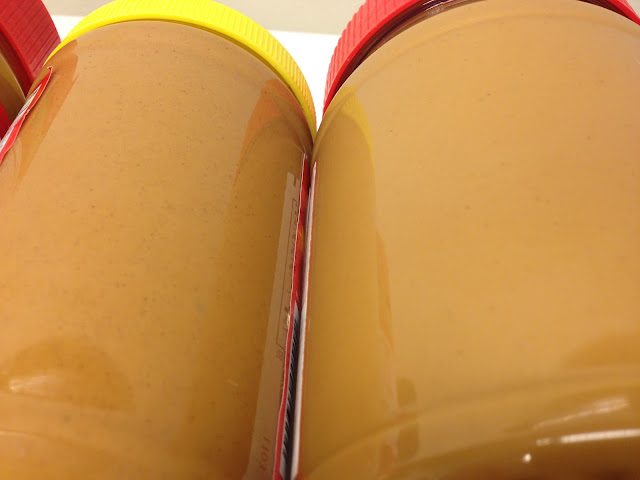Price: As with the Great Value peanuts reviewed last week, the generic chocolate syrup bottle contained less than the brand name version (24 oz. vs. 26 oz.), so once again the savings weren't quite as high as what they appeared to be when just looking at the price. We're not sure if the Hershey's syrup bottle always contains more than the generc bottle, since the Hershey's bottle says it contains an "extra" 2 ounces, but in our shopping experience it seems that products with "extra" or "bonus" labels usually don't change sizes (so it looks like you're getting a great deal, when actually there is no deal, if that's the size the packaging will always be from now on!). After figuring out how much the cost was per ounce, we found the generic chocolate syrup cost about 20% less than the brand name version.
Ingredients: The ingredients in these were exactly the same... which made us wonder if this was one of those situations where the exact same product is just being packaged under different labels (we hear that this happens but are not sure how to confirm it...any ideas??)
Hershey's: high fructose corn syrup, corn syrup, water, cocoa, sugar; contains 2% or less of potassium sorbate (preservative), salt, mono- and diglycerides, xanthan gum, polysorbate 60, vanillin, artificial flavor.
Great Value: high fructose corn syrup, corn syrup, water, cocoa processed with alkali, sugar, contains 2% or less of: potassium sorbate (preservative), salt, mono- and diglycerides, xanthan gum, polysorbate 60, vanillin (artificial flavor).
Calories/Nutritional Information: Both chocolate syrups contained 100 calories per serving, with 0 grams of fat, 15 mg of sodium and 24 grams of carbohydrates per serving.
Appearance: The appearance of the chocolate syrups was identical. They were the same color and appeared to have the same thickness and consistency.
Appearance: The appearance of the chocolate syrups was identical. They were the same color and appeared to have the same thickness and consistency.
Texture/the chew test: Both syrups were equally syrupy - they felt equally sticky/runny when we tested them, both right out of the fridge and at room temperature. We also did a chocolate milk test, and both seemed to mix into the milk equally well.
Taste: We could not tell a difference on taste between these either, both straight and when mixed into the milk... honestly, we think they must be the exact same thing!
Bottom line: We're going to stick with the Great Value chocolate syrup for our future chocolate syrup needs. We just couldn't find a difference between these, and the 20% savings (which would be 25% if the Hershey's bottle ever loses its "extra" two ounces) is worth the switch.
Taste: We could not tell a difference on taste between these either, both straight and when mixed into the milk... honestly, we think they must be the exact same thing!
Bottom line: We're going to stick with the Great Value chocolate syrup for our future chocolate syrup needs. We just couldn't find a difference between these, and the 20% savings (which would be 25% if the Hershey's bottle ever loses its "extra" two ounces) is worth the switch.







